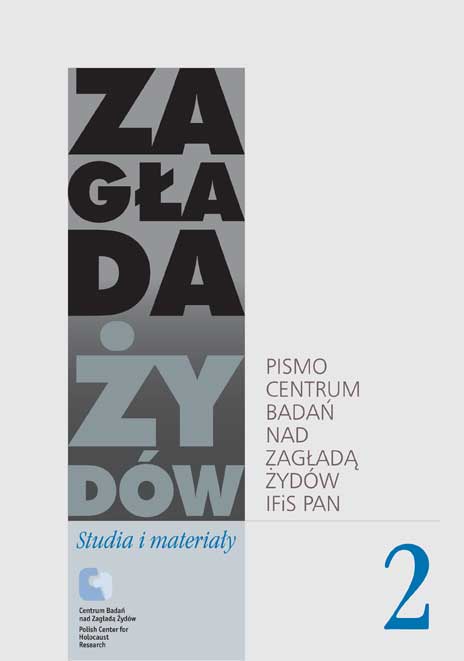Nazistowski mord na Żydach w prasie polskich komunistów (1942–1944).
Zagłada Żydów. Studia i Materiały, Nr 2 (2006), Strony: 54-75
Data zgłoszenia: 2020-10-11Data publikacji: 2006-12-02
 https://doi.org/10.32927/ZZSiM.180
https://doi.org/10.32927/ZZSiM.180
Abstrakt
Facing the decisive struggle between Nazism and Soviet communism for dominance in Europe, in 1942/43 Polish communists sojourning in the USSR espoused anti-German concepts of the political right. Their aim was an ethnic Polish ‘national communism’. Meanwhile, the Polish Workers’ Party in the occupied country advocated a maximum intensification of civilian resistance and partisan struggle. In this context, commentaries on the Nazi judeocide were an important element in their endeavors to influence the prevailing mood in the country: The underground communist press often pointed to the fate of the murdered Jews as a warning in order to make it clear to the Polish population where a deficient lack of resistance could lead. However, an agreed, unconditional Polish and Jewish armed resistance did not come about.
At the same time, the communist press constantly expanded its demagogic confrontation with Polish “reactionaries” and accused them of shared responsibility for the Nazi murder of the Jews, while the Polish government (in London) was attacked for its failure. This antagonism was intensified in the fierce dispute between the Polish and Soviet governments after the rift which followed revelations about the Katyn massacre. Now the communist propaganda image of the enemy came to the fore in respect to the government and its representatives in occupied Poland. It viewed the government-in-exile as being allied with the “reactionaries,” indifferent to the murder of the Jews, and thus acting ultimately on behalf of Nazi German policy. The communists denounced the real and supposed antisemitism of their adversaries more and more bluntly. In view of their political isolation, they coupled them together, in an undifferentiated manner, extending from the right-wing radical ONR to the social democrats and the other parties represented in the underground parliament loyal to the London based Polish government. Thereby communist propaganda tried to discredit their opponents and to justify the need for a new start in a post-war Poland whose fate should be shaped by the revolutionary left. They were thus paving the way for the ultimate communist takeover
Słowa kluczowe
Zagłada , Sowieci a Zagłada , prasa komunistyczna , Katyń , antysemityzm
Licencja
Prawa autorskie (c) 2006 Autor & "Zagłada Żydów. Studia i Materiały"

Utwór dostępny jest na licencji Creative Commons Uznanie autorstwa 4.0 Międzynarodowe.
https://creativecommons.org/licenses/by/4.0
Inne teksty tego samego autora
- Klaus Peter Friedrich, Isaiah Trunk, Łódź Ghetto: A History; Andrea Löw, Juden im Getto Litzmannstadt. Lebensbedingungen, Selbstwahrnehmung, Verhalten , Zagłada Żydów. Studia i Materiały: Nr 3 (2007)
Podobne artykuły
- Dariusz Libionka, Against a Brick Wall. Interventions of Kazimierz Papee, the Polish Ambassador at the Holy See with Regard to German Crimes in Poland, November 1942–January 1943 , Zagłada Żydów. Studia i Materiały: 2008: Holocaust Studies and Materials
- Havi Dreifuss, Matys Gelman – nieznany przywódca nieznanego ruchu chasydzkiego w czasie Zagłady , Zagłada Żydów. Studia i Materiały: Nr 15 (2019)
- Jan Grabowski, Powojenne dochodzenia policyjne we Francji, czyli próba samooczyszczenia paryskiej Prefektury Policji w latach 1944–1946 , Zagłada Żydów. Studia i Materiały: Nr 9 (2013)
- Danijel Matijevic, Jan Kwiatkowski, Krzesiny i Kreising – między pamiętaniem a pomijaniem. Polskie miasteczko wobec historii, pamięci i rywalizacji w cierpieniu , Zagłada Żydów. Studia i Materiały: Nr 10 (2014)
- Bob Moore, W cieniu Anny Frank. Szanse Żydów na przeżycie w okupowanej Holandii , Zagłada Żydów. Studia i Materiały: Nr 10 (2014)
- Ferenc Laczó, Dokumentując odpowiedzialność. Jenő Lévai i narodziny historiografii Zagłady na Węgrzech w latach czterdziestych XX w. , Zagłada Żydów. Studia i Materiały: Nr 10 (2014)
- Havi Dreifuss, „Oni wciąż we mnie żyją”. Israel Gutman (1923–2013): ocalały z Zagłady, uczestnik powstania w getcie warszawskim, historyk żydowski , Zagłada Żydów. Studia i Materiały: Nr 10 (2014)
- Elżbieta Janicka, Zamiast negacjonizmu. Topografia symboliczna terenu dawnego getta warszawskiego a narracje o Zagładzie , Zagłada Żydów. Studia i Materiały: Nr 10 (2014)
- Barbara Engelking, Tajemnica Hesi. Zapis emocji w świadectwach Zagłady , Zagłada Żydów. Studia i Materiały: Nr 10 (2014)
- Marta Janczewska, Warszawska Rada Żydowska w świetle dokumentów urzędowych z Archiwum Ringelbluma , Zagłada Żydów. Studia i Materiały: Nr 10 (2014)
<< < 2 3 4 5 6 7 8 9 10 11 12 13 14 15 16 17 18 19 20 21 22 23 24 25 26 27 28 29 30 31 32 33 > >>
Możesz również Rozpocznij zaawansowane wyszukiwanie podobieństw dla tego artykułu.
 English
English
 Język Polski
Język Polski








